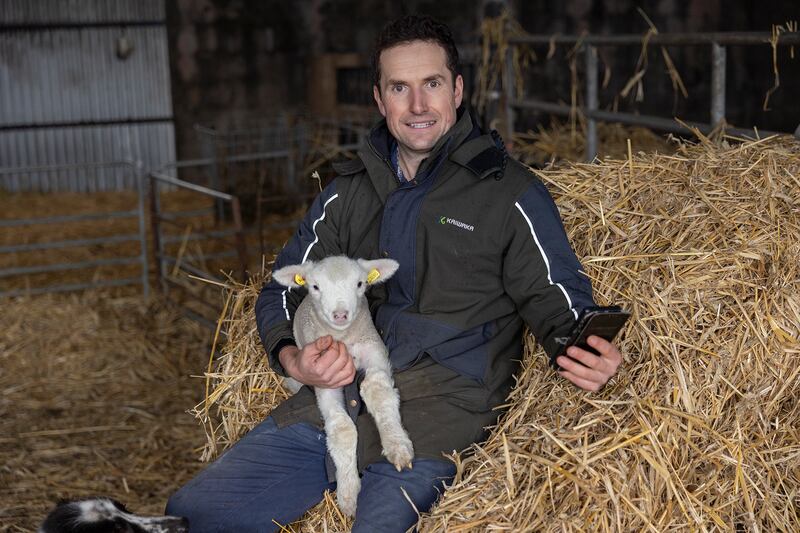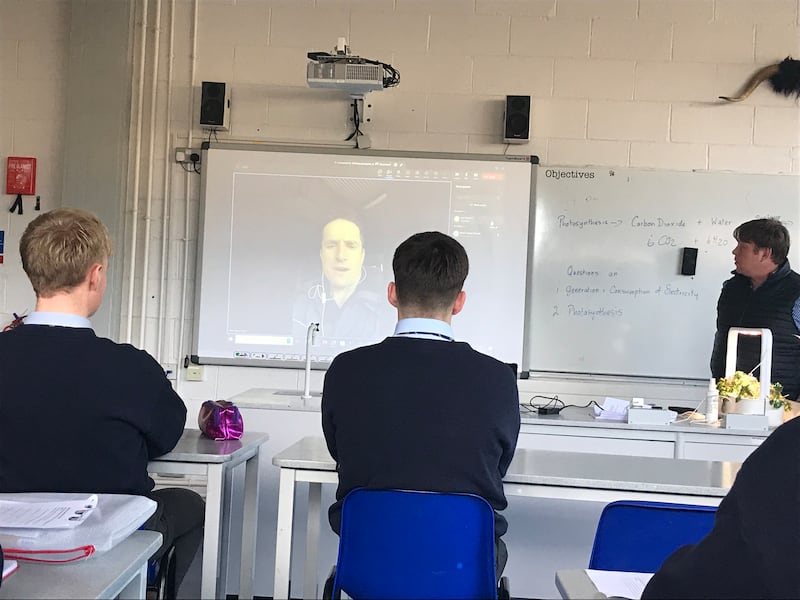It’s Wednesday morning and students at Wesley College are settling into class. The subject is agricultural science, although most students at this suburban Dublin school have no connection to a real, working farm. They are, however, about to get a guided tour with a difference.
Noel Clancy, a farmer from Drangan, Co Tipperary, dials in on a video call to the class. He walks the students through his sheds and fields as he speaks about everything from artificial insemination and vaccinating lambs to sending his sheep to a local abattoir so his lamb could be prepared for sale direct to his customers.
“Sometimes, people think farmers like me are down a boreen in Tipperary but Irish farmers are at the forefront of science and technology,” says Clancy.
There is silence in the class as students watch and listen attentively to this revealing insight into farm life.
RM Block
During the 30-minute video call, he shows students a lamb in a pen drinking milk from a self-feeder because its mother couldn’t feed it. Clancy, who also records the Out the Gap podcast, speaks about the benefits of different breeds of cattle, plot grazing, soil testing and hedge-laying.
And, he describes how the sodden wet fields have made it impossible for some potato farmers to harvest their potatoes with machinery at the moment.
“Buy your potatoes early this year as they might be expensive by Christmas time,” quips Wesley College agricultural science teacher, Iain Wallace.
On a more serious note, both Wallace and Clancy speak about how farmers can face price cuts for their produce while supermarkets continue to sell food at higher prices.
“Someone is still making money on it but it’s not the farmer,” says Wallace. “What you spend your money on has a big impact on farmers,” says Clancy who also acknowledges that longer drier summers and sudden floods will require changing approaches to farming.
Asked by one of the students what steps he is taking to improve sustainability on his farm, Clancy replies that he has cut down on fertiliser use, using more farmyard manure and slurry instead while regularly testing his soil to see exactly what nutrients it requires.

The video call is part of Farmer Time, a new initiative in which farmers share their experiences of farm life through video calls with primary and secondary school students.
It is a recognition that, as our world becomes increasingly urbanised, the real-life connections with farmers and food producers are getting more tenuous.
The initiative is all about improving understanding of farming for future generations while integrating practical learning into the curriculum.
It started in the UK, has been running in Irish schools since 2021. Currently about 90 farmers are paired with primary and secondary schools throughout Ireland reaching about 2,500 children each year.
Wallace, who is the education officer for the Irish Agricultural Science Teachers’ Association, explains that the new agricultural science syllabus has a broad range of modules including food production, breeding and genetics, animal husbandry, nutrition and the environment.
“These students are the consumers of tomorrow. They might not work on farms but the food industry is one of our biggest indigenous industries and even if you work in finance, it’s good to understand where your food comes from,” says Wallace.
He believes the Farmer Time video calls give students a real insight into working farms. “It’s harder and harder for us to leave the school campus due to health and safety on farms, insurance and transport costs so farmers like Noel Clancy can show the students the challenges he faces on the farm at different times of the year,” Wallace says.
He adds that he sometimes brings chickens, sheep and pigs from his hobby farm in Co Wexford to the small farm in the grounds of the Dublin school.
“In the past, a lot of students had an uncle or grandparent on farm but most of the students now – apart from a few boarders – have no connection to farms,” he says.
Wallace argues that there is a lot of pressure on farmers at the moment so it’s important that future generations understand the work they do.

“There is a lot of bad press on agricultural emissions. Farmers have to be more sustainable and environmentally friendly in what they do, yet their input costs are going up and their profit margins are going down,” says Wallace.
Thea Jones is one of only four girls among the sixth-year students taking agricultural science at Wesley College (although the fifth-year class has 16 girls and four boys).
Her family runs a dairy farm in Co Wicklow, which the class visited earlier in the year.
“I help out feeding calves and milking. I’m not sure if I’ll study agricultural science at university but I’m interested in food science,” she explains.
Rian Handley’s mother teaches horse riding and his sisters ride horses too. “My sister did agricultural science in school and then studied sustainability at University College Dublin which crosses over nicely,” he explains.
Finn O’Neill explains that his father, who works in the international marketing of Irish dairy products, encouraged him to take agricultural science for the Leaving Certificate.
Ruth Fitzsimon, who runs the Farmer Time initiative through Airfield urban farm in Dundrum, Dublin (airfield.ie/farmer-time), says that even rural towns have become more urbanised with coffee shops and supermarkets.
“The connection with the land is less and less. Also, so many children go to pet farms but this programme offers them the opportunity to see a real working farm,” she says.
[ Farm accidents: ‘It’s a risky business and really you need good men on machinery’Opens in new window ]
Fitzsimon says the Farmer Time calls can tap into several strands of the primary and secondary school curriculum from maths to geography, history and science. Often teachers will speak with the farmer in advance of the video call so that they can plan their lessons around the content.
Barbara Dagg, a primary schoolteacher at St Patrick’s Loreto School in Bray, Co Wicklow, has been using the programme for two years.
“The students have learned a lot about what cows eat, when calves are born, the weight of animals, vet visits, scanning cows to check for calves and what happens when calves are born,” she explains.
The irony, she says, is that her students have become so involved in a farm that they have never visited.
“There is no way that we miss the calls with PJ the farmer. I wouldn’t have been allowed,” she says.
Farmer Time is free for schools and farmers give their time voluntarily for the programme.
“Farmers are delighted to have the opportunity to represent themselves positively and independently talk to future consumers and potential employees in the food industry,” says Fitzsimon.
Tom Martin, founder of the Farmer Time schools programme in the UK, visited Ireland in the autumn. He explained how his aim is to give every child the opportunity to get to know a farmer and the different jobs they have to do throughout the year.
“We have never been more divorced from where our food comes from yet never more interested in it,” Martin told the audience of food producers and chefs at the Food on the Edge event in Airfield in October.























